A massive dinosaur, the largest animal to walk the Earth, will be revealed by the famous broadcaster and naturalist Sir David Attenborough in an upcoming BBC show. The 37-metre long animal weighed more than 920 average adults or 14 adult African elephants.
The giant dinosaur species Titanosaur, which has not yet been named, weighed up to 70 tonnes and existed 95 million years ago during the late Mesozoic era, a period when dinosaurs ruled the Earth.
It was discovered two years ago – a shepherd saw the tip of a huge fossil bone sticking out from a rock in La Flecha Farm in the Patagonian province of Chubut, Argentina.
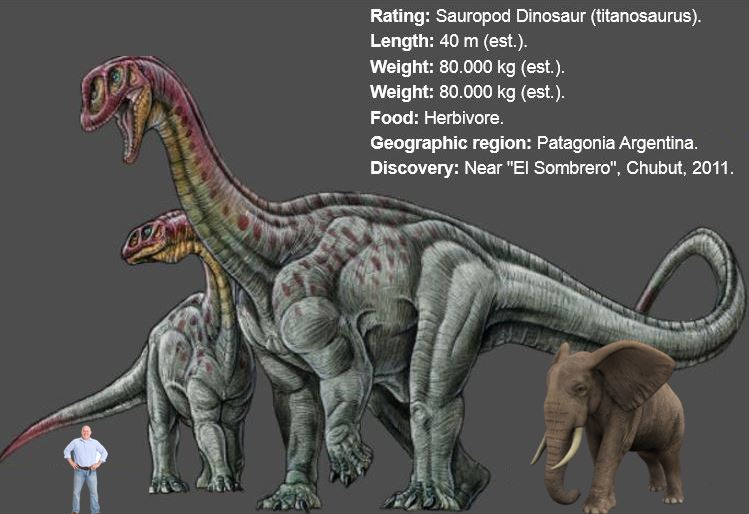 The giant dinosaur weighed the equivalent of 14 African Elephants or 920 average-size human adults. (Image: mef.org.ar)
The giant dinosaur weighed the equivalent of 14 African Elephants or 920 average-size human adults. (Image: mef.org.ar)
Scientists set up excavation camp as soon as they heard
When palaeontologists (fossil specialists) at the Egidio Feruglio Paleontology Museum (Museo Paleontológico Egidio Feruglio) in Trelew, a town in the province of Chubut, found out about it, they went to the area and set up an excavation site.
They were amazed at the size of the first bone they unearthed – a 7.9 foot (2 metre) long thigh bone (femur), the largest femur fossil ever found. Eventually, 220 bones were uncovered from seven different dinosaurs, all of them belonging to a new titanosaur species.
Dr. Diego Pol, who works at the Museum and led the excavation, said:
“It was like a paleontological crime scene, a unique thing that you don’t find anywhere else in the world with the potential of discovering all kinds of new facts about titanosaurs. According to our estimates this animal weighed 70 tons.”
“A comparison of the back bones shows that this animal was 10 per cent larger than Argentinosaurus, the previous record holder. So we have discovered the largest dinosaur ever known.”
Dinosaur specialist José Luis Carballido, leader of the team studying dinosaurs at the museum, said:
“It’s a real paleontological treasure. There were lots of fossils in great preservation, practically intact, something that does not happen often. In fact, the remains of giant Titanosaurs known so far are scarce and fragmentary.”
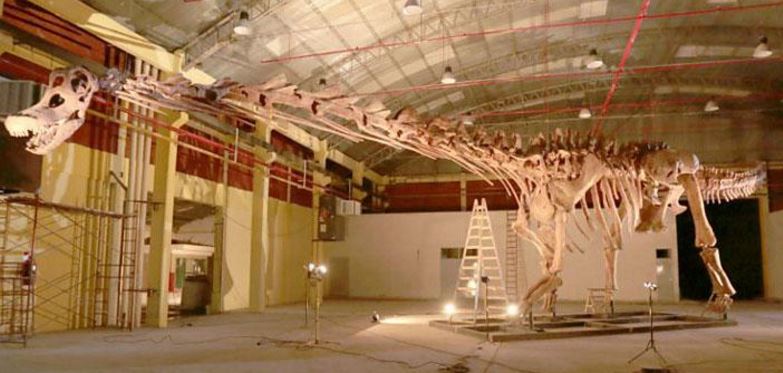 A team of Canadian and Argentinian model makers created this magnificent skeleton of the newly-discovered giant dinosaur. (Image: mef.org.ar)
A team of Canadian and Argentinian model makers created this magnificent skeleton of the newly-discovered giant dinosaur. (Image: mef.org.ar)
Sir David’s documentary – Attenborough and the Giant Dinosaur – will be broadcast on Sunday 24 January on BBC One. The show follows the twists and turns of this 2-year forensic study.
Scientists explain how the dinosaur lived
Sir David was witness to the unearthing, cleaning and examination of these gigantic fossil bones. Using state-of-the-art graphics, the documentary shows what the scientists believe the internal structure of the huge animal looked like, and how it functioned and moved.
Before this Titanosaur was discovered, experts worldwide were pretty sure that these giants existed many millions of years ago, but knew very little about them because the very few fossils that were around were in bad condition.
 The archaeologists unearthed the world’s largest-ever thigh bone at the excavation site. (Image: mef.org.ar)
The archaeologists unearthed the world’s largest-ever thigh bone at the excavation site. (Image: mef.org.ar)
In this documentary, Sir David takes us to the excavation site to witness the unearthing of these enormous specimens, and then to the museum laboratory in Trelew where they are cleaned and examined further.
Comparative anatomy experts and palaeontologists explain what the bones of this massive Titanosaur tell us about its life, with the help of CGI visuals, 3D scanning and computer animation.
At the end of the show we witness the unveiling of the breathtaking 37-metre long skeleton model of the newly-discovered Titanosaur species, built by a team of Canadian and Argentinian model makers.
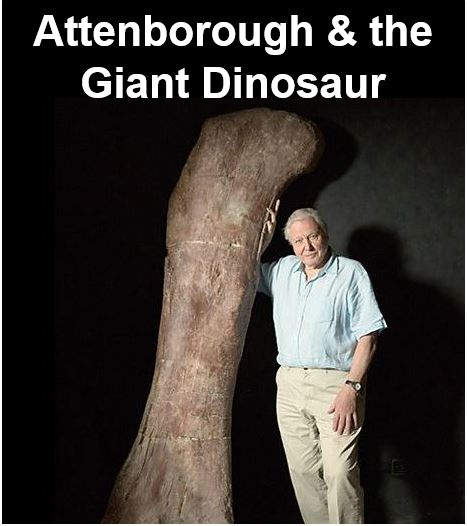 Sir David talked with BBC Today programme presenter Nick Robinson about the dinosaur and how they worked out its dimensions from the bones that were discovered. (Image: bbc.co.uk)
Sir David talked with BBC Today programme presenter Nick Robinson about the dinosaur and how they worked out its dimensions from the bones that were discovered. (Image: bbc.co.uk)
Why did so many die in the same place?
Why would seven adults die all in the same place? Maybe there was a watering hole at the excavation site 95 million years ago, and during a severe drought they congregated in large numbers, where some of them died of dehydration.
Perhaps some of the weaker ones got stuck in the mud and couldn’t get out, some scientists suggest.
Scavenging dinosaurs like Tyrannotitan would definitely have come to the area to feast on the dead bodies, researchers said.
Carballido said, regarding Tyrannotitan:
“They probably frequented the place to scavenge the remains of herbivores. But the feast had high price: to bite hard skin and flesh of these giants often broke their teeth, that later regenerated.”
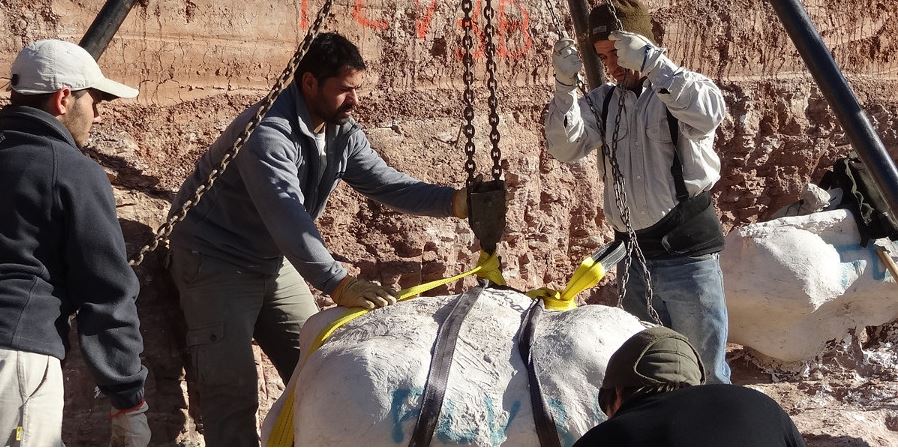 Giant bones within large boulders required lifting equipment to get the specimens out of the ground. (Image: mef.org.ar)
Giant bones within large boulders required lifting equipment to get the specimens out of the ground. (Image: mef.org.ar)
The name of this new dinosaur species will be revealed once details of its discovery are published in a scientific paper.
The team also found prehistoric remains of large plants at the excavation site, including some imprints of leaves and large logs, which suggest that the Patagonian landscape at the time was very different. Ninety-five million years ago there were many large trees in the region.
Ben Garrod appears in documentary with childhood hero
Evolutionary biologist Ben Garrod, a teaching fellow at Anglia Ruskin University, will also be on the BBC show with his childhood hero (Sir David). Dr. Garrod has hosted his own BBC 4 series and is a regular guest on The One Show.
In an interview with Cambridge News, Garrod said:
“I was walking through Paddington station and my phone rang and it was a producer from the BBC who asked me about a new show. She said it would be jumping from BBC Four to One, which is wonderful and she said it’s about dinosaurs, and I love dinosaurs.”
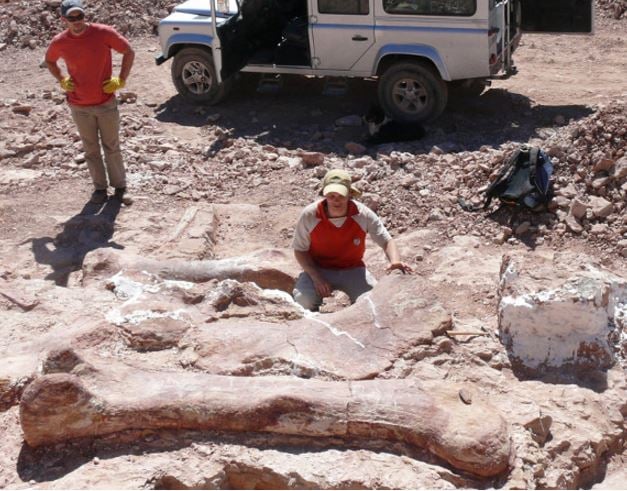 Members of the excavation team were stunned by the size of the fossil bones. (Image: mef.org.ar)
Members of the excavation team were stunned by the size of the fossil bones. (Image: mef.org.ar)
“Then she said it’s the biggest dinosaur ever discovered, you would be involved in the dig, and it’s with David Attenborough. It was one of those random moments in the middle of Paddington that changes your life.”
“For a documentary this was done really quickly, it has taken less than two years. At the start of this the dinosaur was in the ground and barely recognisable, and now the whole thing has been scanned, reassembled and all the bones cleaned, and the team has written a scientific paper and we’ve made a programme about it.”
Dr. Garrad, who grew up in Norfolk, says he vividly remembers going along the beach with his grandfather, then getting home to watch Attenborough on TV. He says to have developed from that inspiration as a child to knowing the man quite well now is ‘amazing’.
 Ben Garrod (left), Sir David Attenborough (middle) and Diego Pol with the new giant titanosaur find behind. (Image: bbc.co.uk)
Ben Garrod (left), Sir David Attenborough (middle) and Diego Pol with the new giant titanosaur find behind. (Image: bbc.co.uk)
Dr. Garrad added:
“It was lovely, not because of who he is but what he has got, which is endless passion and drive for the natural world. He would be the first up in the mornings and the last one to leave at night, and still so interested.”
“It was a bit daunting doing a piece to camera with David watching, he has a great poker face, then just at the end he said ‘you did well’, which was amazing.”
BBC Video – Attenborough and the Giant Dinosaur
On Sunday 24 January on BBC 1, Sir David Attenborough will tell us about the fossil discovery and reconstruction in Argentina of the largest known dinosaur, a new species of Titanosaur.

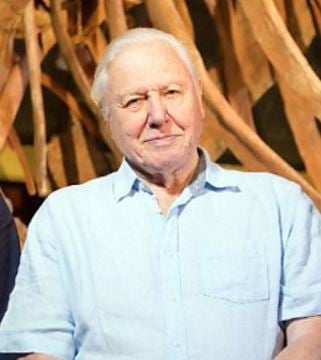
Comments are closed.